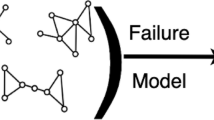Abstract
In this paper, we introduce a measure to analyse the structural robustness of complex networks, which is specifically applicable in scenarios of targeted, sustained attacks. The measure is based on the changing size of the largest component as the network goes through disintegration. We argue that the measure can be used to quantify and compare the effectiveness of various attack strategies. Applying this measure, we confirm the result that scale-free networks are comparatively less vulnerable to random attacks and more vulnerable to targeted attacks. Then we analyse the robustness of a range of real world networks, and show that most real world networks are least robust to attacks based on betweenness of nodes. We also show that the robustness values of some networks are more sensitive to the attack strategy as compared to others. Furthermore, robustness coefficient computed using two centrality measures may be similar, even when the computational complexities of calculating these centrality measures may be different. Given this disparity, the robustness coefficient introduced potentially plays a key role in choosing attack and defence strategies for real world networks. While the measure is applicable to all types of complex networks, we clearly demonstrate its relevance to social network analysis.








Similar content being viewed by others
Notes
We will sometimes refer to this phenomena simply as ‘phase transition’, when the context is clear.
Of course, the exact size of the largest component at each time step will depend on the network topology and the type of attack. The figure only shows a typical case, to be contrasted with Fig. 2.
References
Albert R, Barabási AL (2002) Statistical mechanics of complex networks. Rev Mod Phys 74:47–97
Albert R, Jeong H, Barabási AL (2000) Error and attack tolerance of complex networks. Nature 406:378–382
Alon U (2007) Introduction to systems biology: design principles of biological circuits. Chapman and Hall, London
Baumbach J (2007) Coryneregnet 4.0-a reference database for corynebacterial gene regulatory networks. BMC Bioinf 8
Bonacich P (2001) Eigenvector-like measures of centrality for asymmetric relations. Soc Netw 23(3):191–201
Cazabet R, Takeda H, Hamasaki M, Amblard F (2012) Using dynamic community detection to identify trends in user-generated content. Soc Netw Anal Min 2(4):361–371
Colizza V, Flammini A, Serrano MA, Vespignani A (2006) Detecting rich-club ordering in complex networks. Nat Phys 2:110–115
Collations of connectivity data on the Macaque brain (2009) URL:http://www.cocomac.org/
Costa LDF, Rodrigues FA, Travieso G, Villas Boas PR (2007) Characterization of complex networks: a survey of measurements. Adv Phys 56(1):167–242
Crucittia P, Latora V, Marchiori M, Rapisarda A (2004) Error and attack tolerance of complex networks. Phys A 340:388–394
Dekker AH, Colbert BD (2004) Network robustness and graph topology. In: Proceedings of the 27th Australasian conference on computer science. ACSC ’04, vol 26, Australian Computer Society Inc., Darlinghurst, pp 359–368
Dorogovtsev SN, Mendes JFF (2003) Evolution of networks: from biological nets to the internet and WWW. Oxford University Press, Oxford
Gilbert F, Simonetto P, Zaidi F, Jourdan F, Bourqui R (2011) Communities and hierarchical structures in dynamic social networks: analysis and visualization. Soc Netw Anal Min 1(2):83–95
Gleiser P, Danon L (2003) Adv Complex Syst 6:565
Hanley JA, Mcneil BJ (1982) The meaning and use of the area under a receiver operating characteristic (ROC) curve. Radiology 143(1):29–36
Junker BH, Schreiber F (2008) Analysis of biological networks (Wiley Series in Bioinformatics). Wiley, New York
Kepes F (2007) (ed) Biological networks. World Scientific, Singapore
Kreyszig E (2005) Advanced engineering mathematics, 9th edn. Wiley, New York
Lusseau D, Schneider K, Boisseau OJ, Haase P, Slooten E, Dawson SM (2003) Dolphin social network. Behav Ecol Sociobiol 54
Michigan Molecular Interaction Database (2008) University of Michigan URL:http://mimi.ncibi.org/MimiWeb/main-page.jsp
Milgram S (1967) The small world problem. Psychol Today 1:61
Newman MEJ (2002) Assortative mixing in networks. Phys Rev Lett 89(20):208–701
Newman MEJ (2005) A measure of betweenness centrality based on random walks. Soc Netw 27(1):39–54
Ng AKS, Efstathiou J (2006) Structural robustness of complex networks. Phys Rev 3:175–188
Noh JD Rieger H (2004) Random walks on complex networks. Phys Rev Lett 92:118–701
Pajek datasets (2007). URL: http://vlado.fmf.uni-lj.si/pub/networks/data
Piraveenan M, Prokopenko M, Zomaya AY (2008) Local assortativeness in scale-free networks. Europhys Lett 84(2):28–002
Piraveenan M, Prokopenko M, Zomaya AY (2009) Assortativity and growth of Internet. Eur Phys J B 70:275–285
Piraveenan M, Prokopenko M, Zomaya AY (2010) Local assortativeness in scale-free networks—addendum. Europhys Lett 89(4):49–901
Primary school cumulative networks (2011) URL:http://www.sociopatterns.org/datasets/primary-school-cumulative-networks/
Rees BS, Gallagher KB (2012) Overlapping community detection using a community optimized graph swarm. Soc Netw Anal Min 2(4):405–417
Solé RV, Valverde S (2004) Information theory of complex networks: on evolution and architectural constraints. Complex networks In: Ben-Naim E, Frauenfelder H, Toroczkai Z (eds) Lecture notes in physics, vol 650. Springer, Berlin
Tang A, Honey C, Hobbs J, Sher A, Litke A, Sporns O, Beggs J (2008) Information flow in local cortical networks is not democratic. BMC Neurosc 9(Suppl 1):O3
Venkatasubramanian V, Katare S, Patkar PR, Mu F (2004) Spontaneous emergence of complex optimal networks through evolutionary adaptation. CoRR nlin.AO/0402046
Watts DJ, Strogatz SH (1998) Collective dynamics of small-world networks. Nature 393(6684):440–442
Zachary W (1977) An information flow model for conflict and fission in small groups. J Anthropol Res 33:452–473
Zaidi F (2013) Small world networks and clustered small world networks with random connectivity. Soc Netw Anal Min 3(1):51–63
Zhou S, Mondragón RJ (2004) The rich-club phenomenon in the internet topology. IEEE Commun Lett 8:180–182
Author information
Authors and Affiliations
Corresponding author
Rights and permissions
About this article
Cite this article
Piraveenan, M., Thedchanamoorthy, G., Uddin, S. et al. Quantifying topological robustness of networks under sustained targeted attacks. Soc. Netw. Anal. Min. 3, 939–952 (2013). https://doi.org/10.1007/s13278-013-0118-8
Received:
Revised:
Accepted:
Published:
Issue Date:
DOI: https://doi.org/10.1007/s13278-013-0118-8




